On the eastern side of Newfoundland is one of the most picturesque peninsulas we’ve seen. With countless rugged capes, dramatic cliffs and spectacular sea stacks, we were treated to some of the most stunning scenery.
After exploring Newfoundland’s west coast it was time to move east. The only way to drive between the east and west coasts of the province is to follow the TransCanada Highway along the island’s northern edge.


Situated roughly in the middle of Newfoundland’s east coast is Canada’s most eastern National Park. Spread along the edge of Bonavista Bay is Terra Nova National Park. The 80 km of hiking trails in the park take you to the many lakes and inlets and to lookouts on the tops of small rounded mountains. It was cloudy and rainy when we arrived so we knew we wouldn’t hike to a lookout. Instead we followed a trail that took us toward Southwest Arm Lookout. It’s a nice area with dense vegetation surrounding a quiet pond. The ground is marshy and at times you follow wooden boardwalks to cross the wet ground. We could see kayakers further down the water and thought it would be a nice place to explore by kayak or canoe.

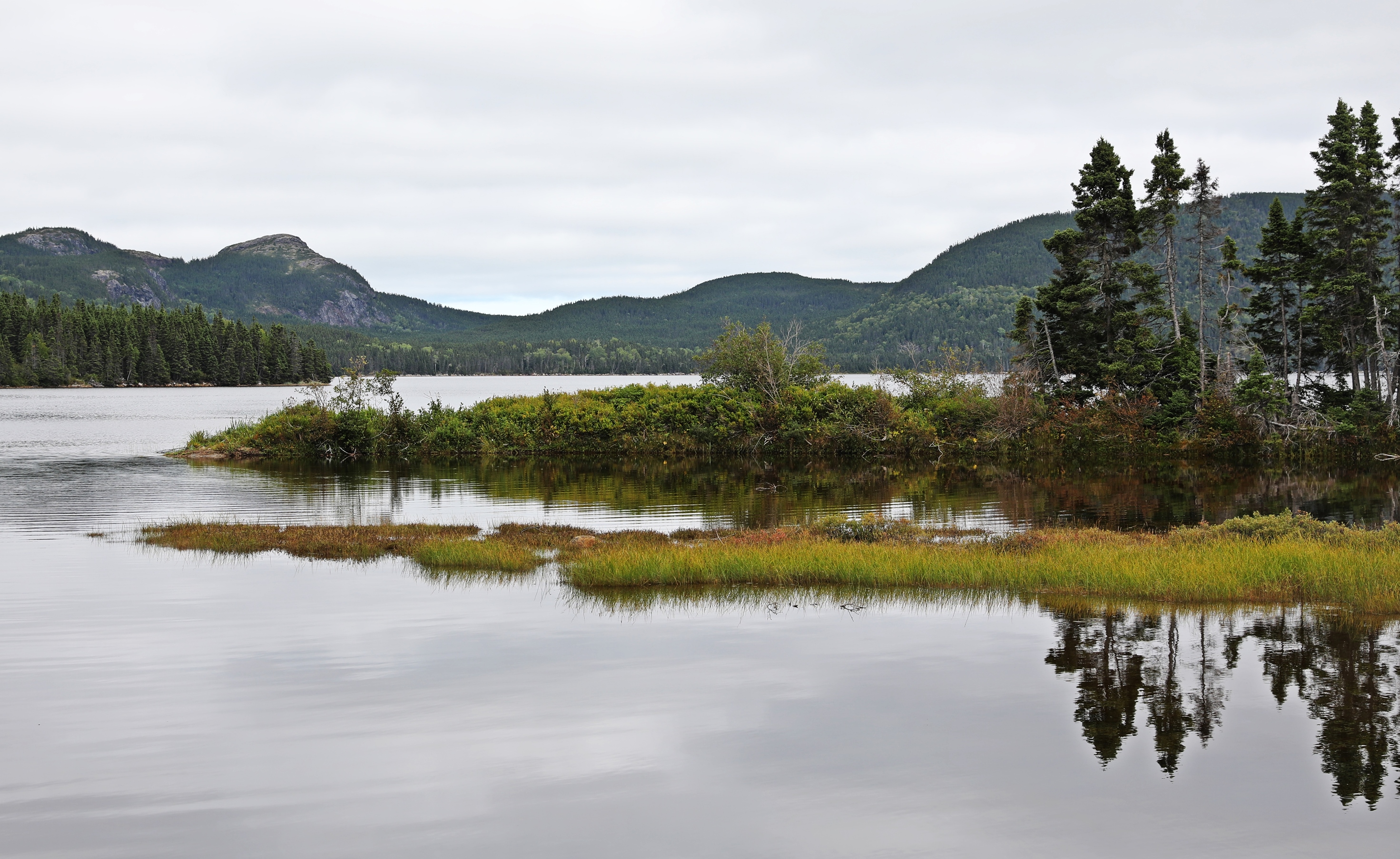
Just south of the park is the turnoff to Bonavista Peninsula. This large peninsula juts out into the Atlantic Ocean creating Bonavista and Trinity Bays. On the northern coast of this peninsula is a lesser known lighthouse with spectacular coastal views. A short hiking trail leaves from Saints Peter and Paul Church in King’s Cove. The trail passes through Pat Murphy Meadow which was the inspiration for a Newfoundland folk song of the same name. The meadow’s name was one of our first indications of the long Irish history on Newfoundland.
King’s Cove Lighthouse is a tall white tower on top of a very rocky crag. The lighthouse is nice, but even better are the stunning views from its perch. From the rocky point we looked along the coast to see wonderfully, colourful layers of sedimentary rock projecting out into a very rough Atlantic Ocean. It was our first of many spectacular coastal views on this peninsula.
Note: If you’re driving to the lighthouse, follow the directional signs on the highway. Google Maps tried to send us somewhere else.



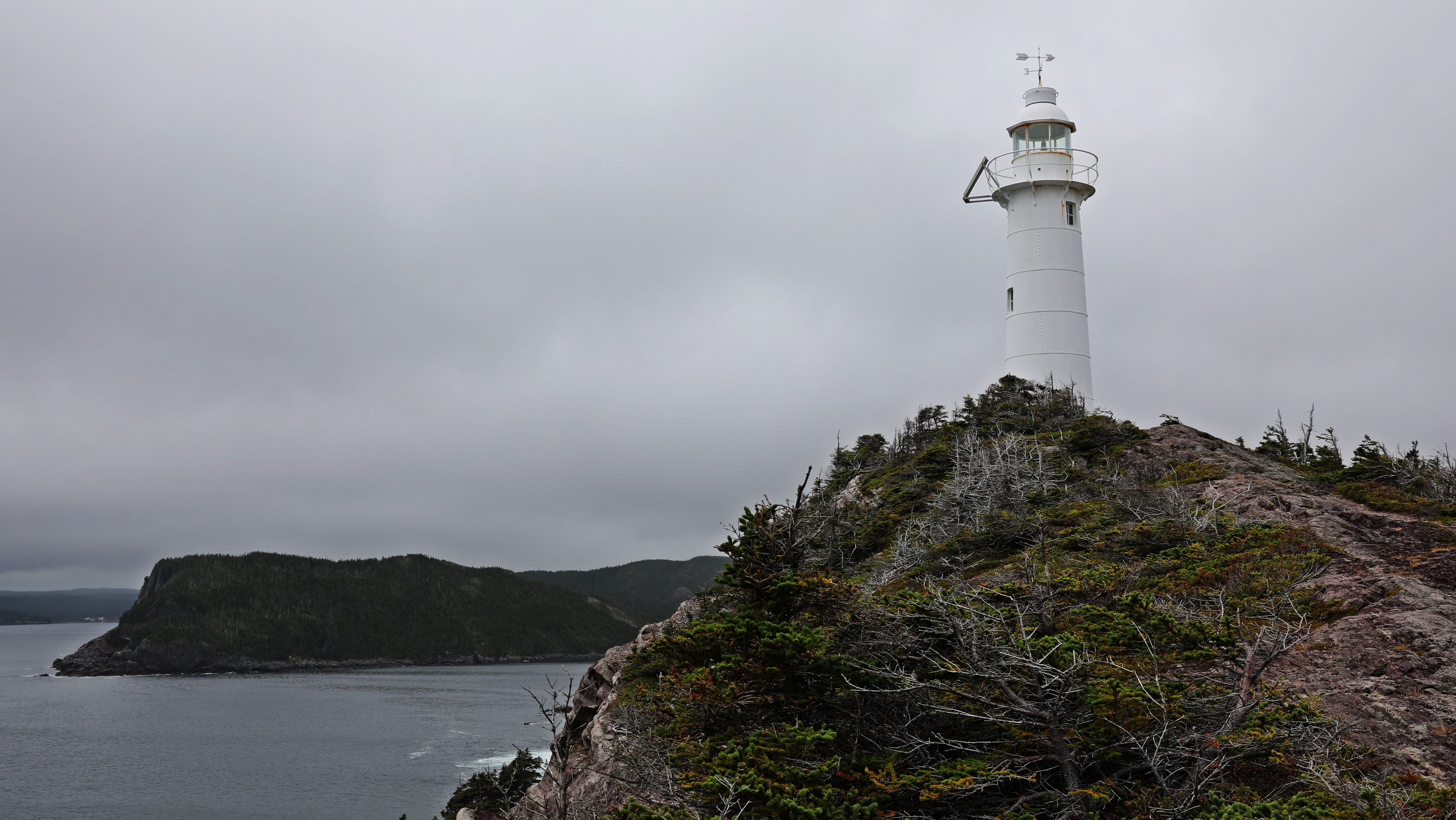

The names Bonavista and Newfoundland have interesting origins that are part of the same story. In 1497 John Cabot (Giovani Caboto) was sailing his ship ‘The Matthew’ for King Henry VII. The English king had hired the Italian explorer to search for unknown lands. The story says that when Cabot saw the tip of Bonavista Peninsula, he exclaimed in Italian ‘O Buono Vista’ (Oh Happy Sight), giving the peninsula its name. Apparently months later, when Cabot let the king know of the land he had ‘discovered’, King Henry VII called it ‘New Found Launde’. Although it is disputed where exactly Cabot first saw this new land, the Newfoundland government holds to its belief that it was near the tip of Bonavista Peninsula.
Not long after Cabot’s voyage, fishermen arrived to the shores of the ‘new found launde’ from Portugal, France and England. They only came to the area for seasonal fishing though, returning to their home countries in the off-seaon.
The town of Bonavista was established much later in the 17th century. Today Bonavista is a nice spot with a pretty historical centre and a busy harbour. A re-creation of ‘The Matthew’ can be visited in town at Ye Matthew Legacy Building. Bonavista was the location for the 2001 film ‘The Shipping News’. The rainy weather seemed to fit with our memory of that movie.


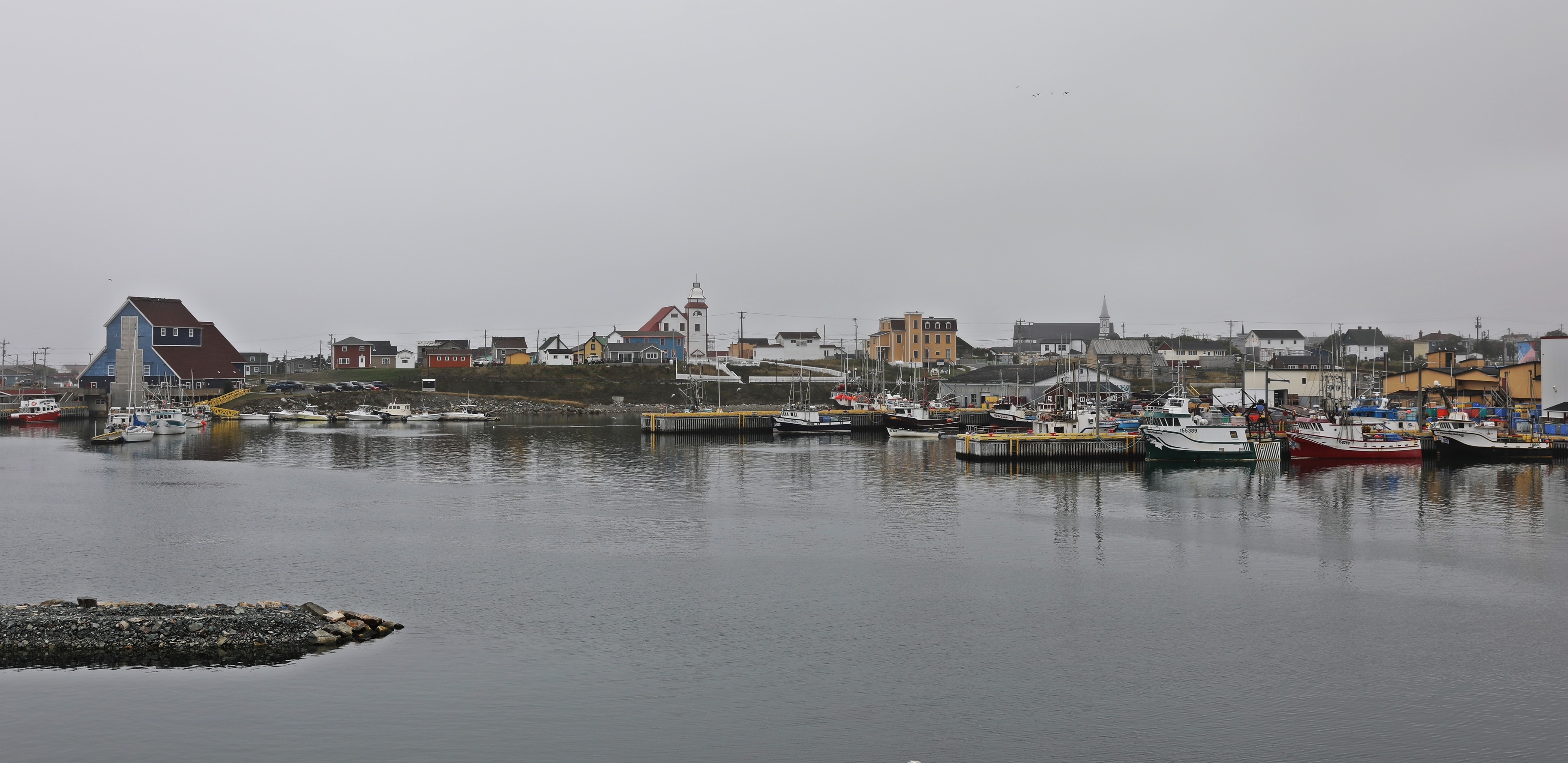
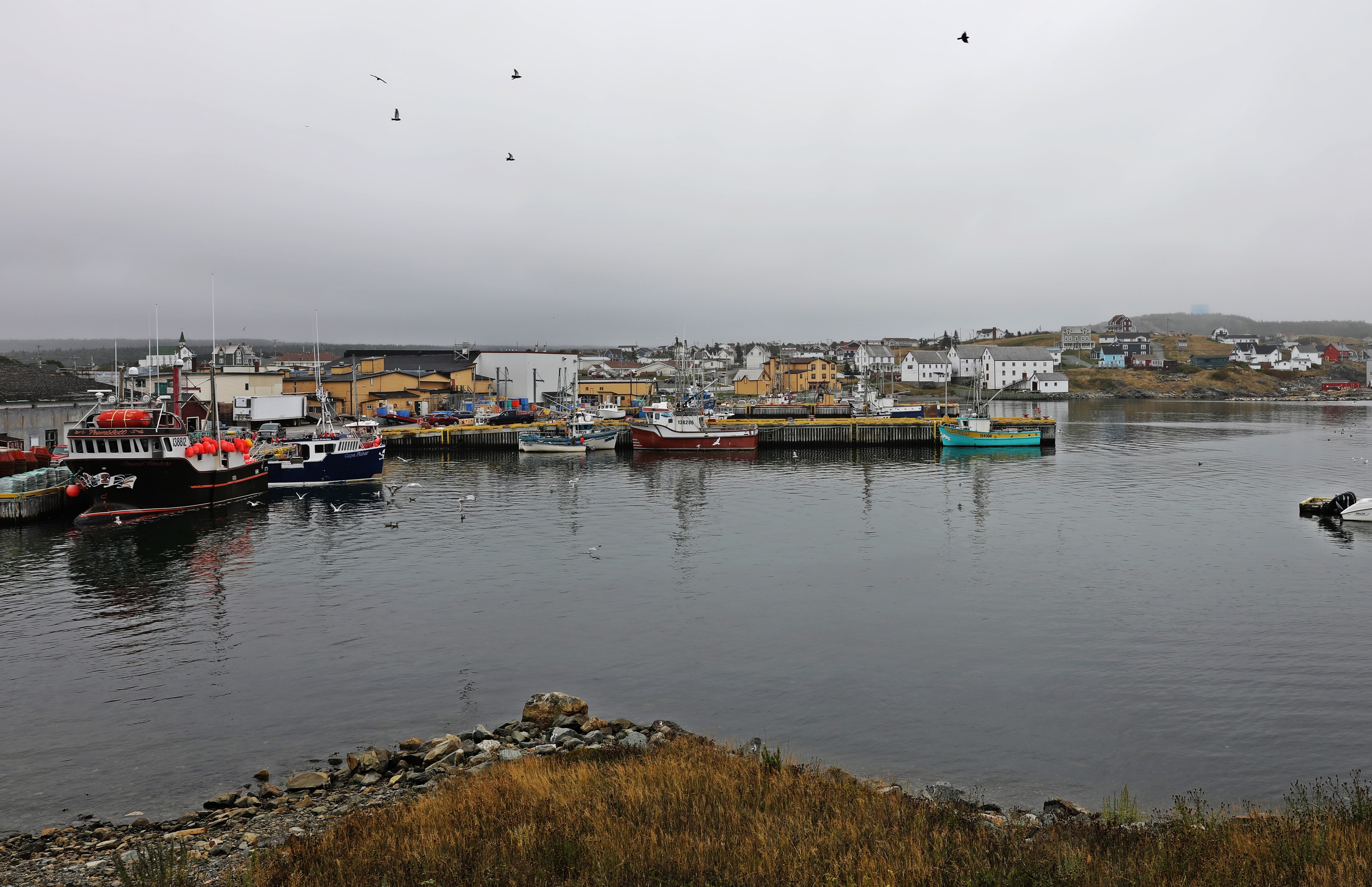

Not far from town, at the very tip of the peninsula, is a wild coastline with jagged inlets and rocky cliffs. On the highest point of the cape is the funny looking red and white stripped Cape Bonavista Lighthouse. The unusual shape of the lighthouse is due to the large 2-story lightkeeper’s residence at the base of the tower. The building today is only a replica since the original home, built in 1841, was damaged in a storm. Even though the lighthouse is no longer operational, the fog horn still works and as we discovered, it is very loud.
Surrounding the lighthouse is a spectacular rugged coast with deep inlets and a boiling ocean.



The rugged Bonavista coastline continues all the way to Dungeon Provincial Park. It is a small coastal park but has stunning views and a fantastic feature on its cliffside. Years of waves eroded the cliffs creating a large cavern. Eventually the roof of the cavern caved in leaving a huge dungeon like hole with two arches. It is still connected to the mainland and you can walk above the arches on the connecting bridge. Apparently one day this bridge will also collapse leaving sea stacks behind.
The park is free, and is not far off the road between Bonavista and Elliston.



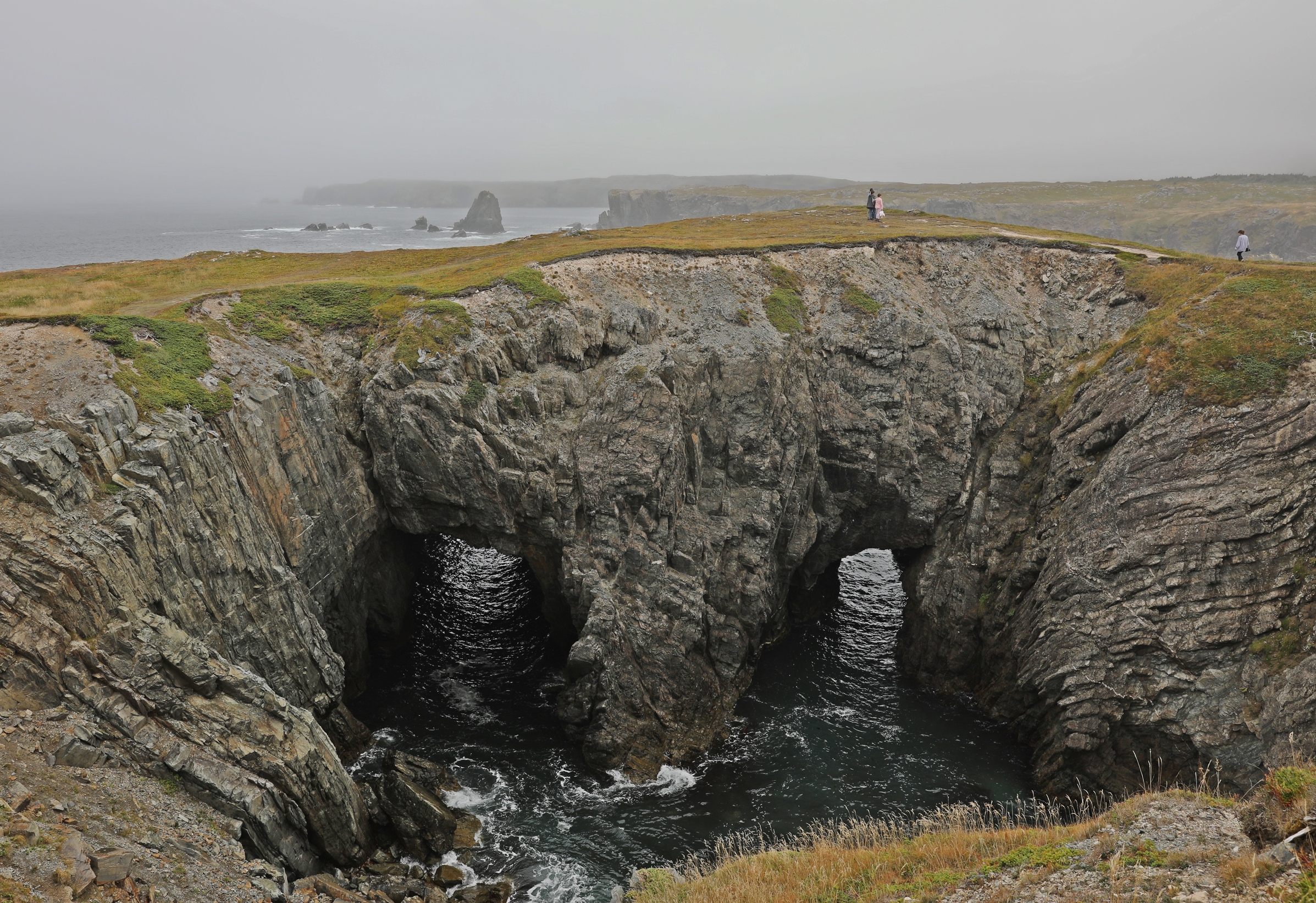
The main reason we came to Bonavista Peninsula was to see puffins, Newfoundland’s official bird. Atlantic Puffins are quite small, the size of a pigeon but they are very cute. These black and white birds have large colourful orange and yellow beaks on the end of a round head. Topping off their cuteness are their sunken eyes that look like buttons on a teddy bear.
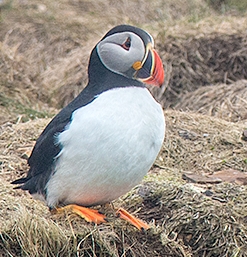
These birds are very hardy and spend most of their lives in the roughest conditions. During the majority of the year they live in the middle of the North Atlantic. In summers though, they come to the east coast to breed. Six kilometers from Bonavista is one of the best places to see puffins in the summer. Elliston Point looks out on to a grass covered, flat topped island where puffins have their nests.
What makes this spot in Elliston special is that it is the closest you can get to their nesting spots. The lookout point is only 30 m from the island. Other nesting sites can only be seen by boat. The other part that makes Elliston special is that puffins may come near you on the mainland. Apparently, they are friendly and very curious and often land near people at the lookout. They won’t land if it’s too noisy or if there are a lot of people. We were told to be quiet and crouch low on the grass so we would look less intimidating. We did our best but weren’t lucky. No puffins landed near us.


We were there in September which is a little late in the season. What is a large colony mid summer was just a few stragglers in the fall. We did however see at least 6 puffins flying around their island. We watched as they flew between their their nests on the island and the sea. The birds dove into the rough ocean and came up with mouthfuls of fish. They then returned to their nests with small fish clutched in their mouths. Unlike many birds, they feed whole fish to their babies, not a regurgitated one. The island is also home to a number of other sea birds. These larger birds soared overheard while one of the puffin pair stood guard at the nest’s entrance.
Out of all of the birds flying around the island it was easy to spot which birds were puffins. They’re funny fliers and easily recognizable. We learned to watch for the tell-tale frantic flapping of wings as they approached. Even though there were only a few puffins, they were constantly flying to and from the rough ocean allowing us to watch and enjoy.


Our Bed & Breakfast host told us about another spot where we might see puffins. Although we didn’t see any of the cute birds, we loved the hike to the point beside Spillar’s Cove. Huge sea stacks dot the cliff edges and large rocks fill the deep inlets. They were some of the most spectacular coastal views we’d seen and we were the only ones there.



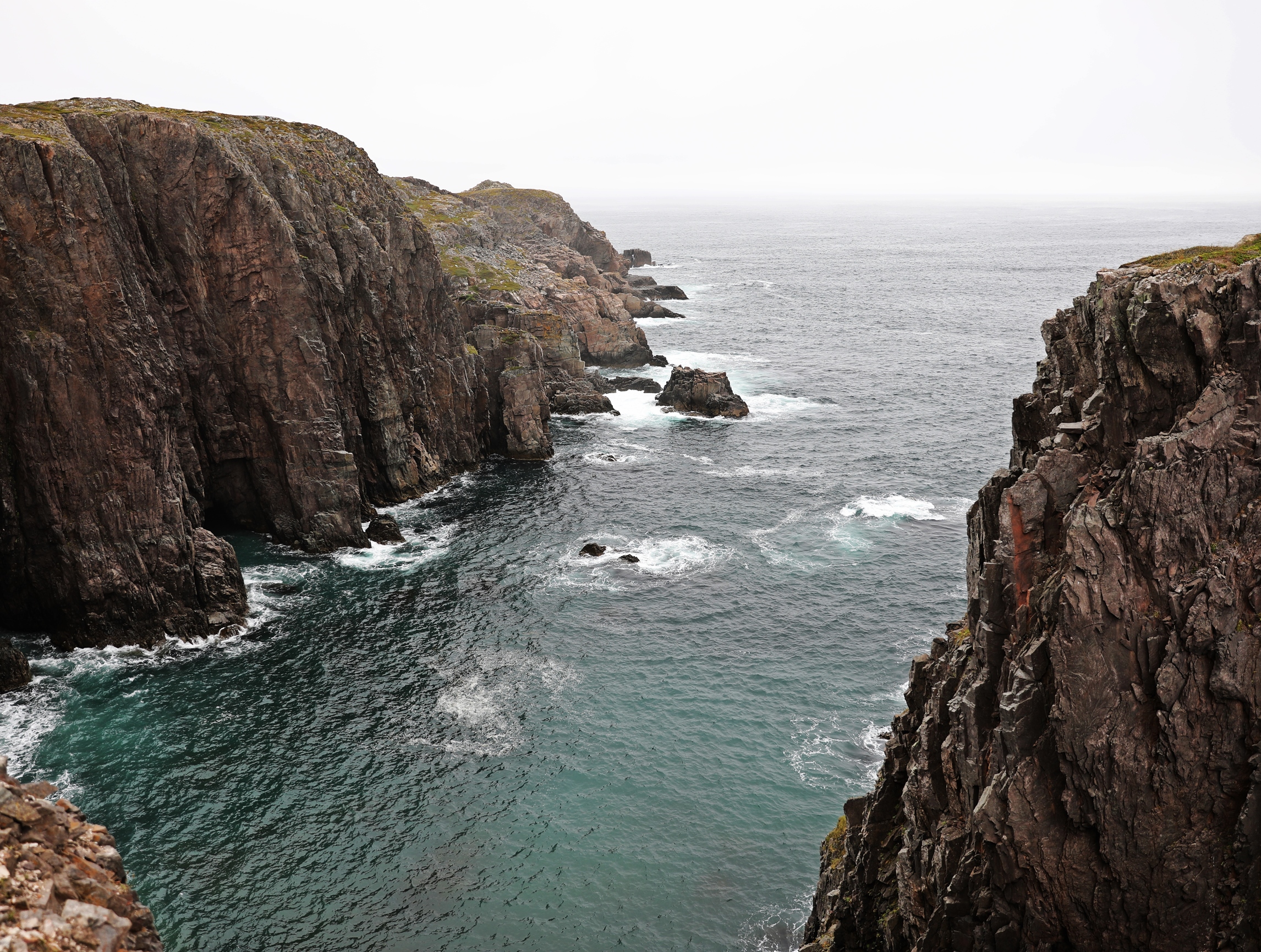
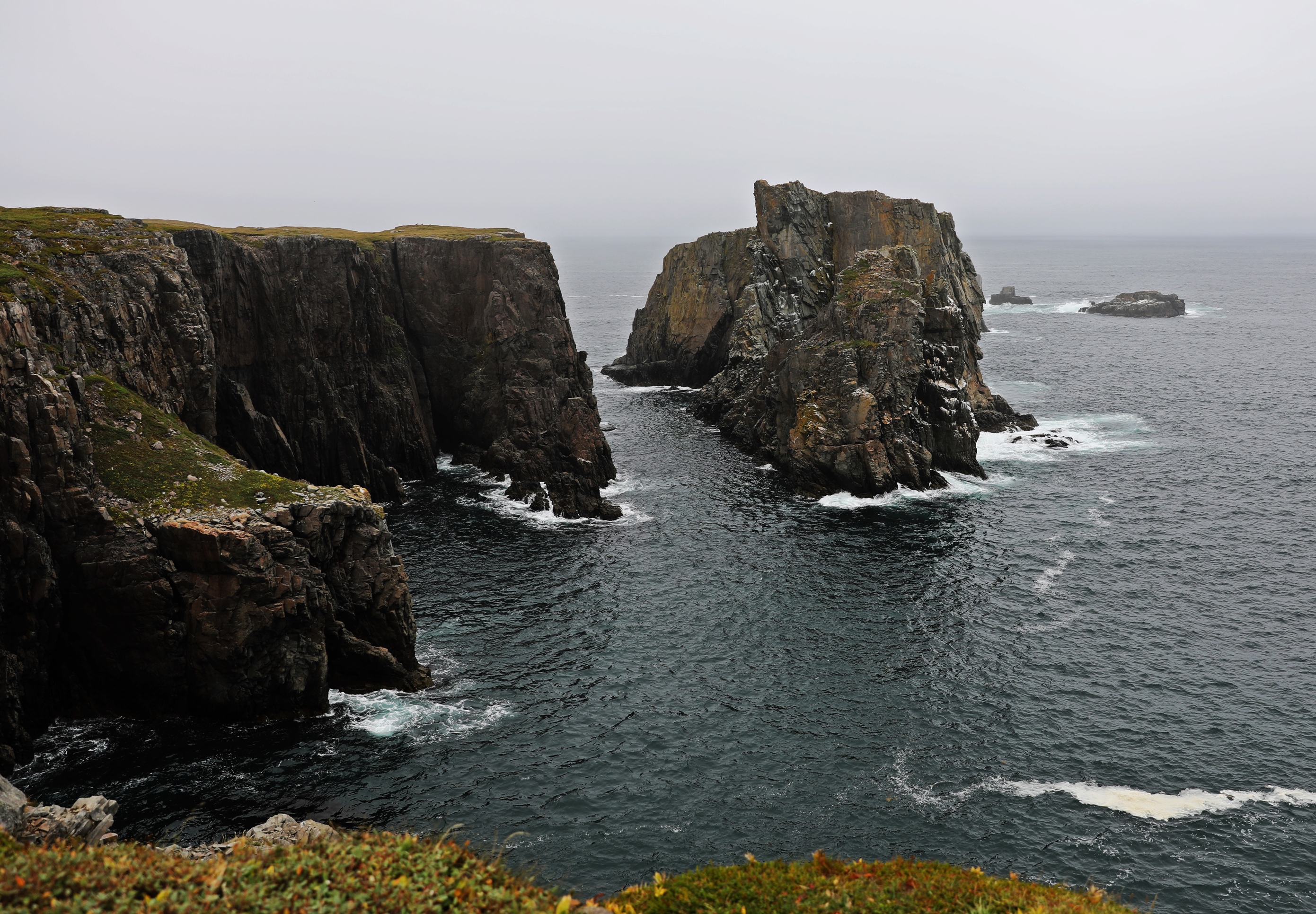
There is a hike called the Klondike Trail that follows the coastline between Elliston and Spillar’s Cove. You can do the hike or do as we did and drive between the two short hikes.
After leaving Elliston we were on our way to one of the cutest towns in Newfoundland, Trinity.
Tips for Visiting Newfoundland
- The TransCanada Highway in Newfoundland is shaped like a horseshoe as it travels along the west, north and eastern edge of the island province. There are smaller highways leading to the various capes, but in order to get from east to west, you have to drive all around the northern edge. There are no shortcuts across the island. It will take a full day to drive from one side to the other. There are quite a few potholes across the province so drive with caution.
- Watch for moose while driving, especially between dusk and dawn. With 125,000 moose on the island there are, on average 700 moose-car collisions per year.
- If you’re planning to rent a car or RV, the best advice is to book early. Even when there isn’t a worldwide pandemic, there are not many available.
- Newfoundland Standard Time is 30 minutes ahead of Atlantic Standard Time so do don’t forget to change your watch.
- Don’t confuse St. John’s, Newfoundland’s capital city with St. John in New Brunswick.
Where to stay on Bonavista Peninsula
Camping – Lockston Path Provincial Park is located in the middle of the peninsula, not far from Trinity. We found this a convenient location as well as a quiet, clean and affordable campground.
Hotels/Bed & Breakfast – There is a growing number of availabe hotels and B&Bs on Bonavista Peninsula. Depending on what sites you want to see, you can find many options in Trinity, Bonavista and Elliston. We loved staying in Meems Elliston B&B. The friendly hosts, clean and comfy rooms and great location makes it a great option.
Getting to Newfoundland
Marine Atlantic ferries travel between Sydney, NS and western Newfoundland’s Port aux Basques (7 hrs) twice a day and to the eastern province’s Argentia a few times a week. If traveling to or from Argentia is a long 16 hour trip, usually overnight. Another ferry travels from Blanc-Sablon, Quebec to St. Barbe on the Great Northern Peninsula. This ferry is much closer to L’Anse aux Meadow, however it is a long and difficult drive to reach the Quebec Port.
Most flights travel to St. John’s, but there are also international airports in Stephenville and Gander. Gander is famous for accepting planes from the US during 9/11.
Read more about Newfoundland – The Adorable Town of Trinity, Western Newfoundland, Gros Morne National Park, Vikings in Newfoundland, Conception Bay, St. John’s, Signal Hill, Day Trips from St. John’s
For more pictures from our travels around the world visit Gallery on monkeystale.ca
To read stories from other parts from Canada click here, or other countries visit Destinations.
If you like what you read please share, with credit, using one of the links below.
Stunning landscapes, but I guess not the best place for a beach vacation.
LikeLiked by 2 people
Haha no in fact I’m not sure there’s a beach on the entire island!
LikeLike
I can almost hear the waves crashing onto the rocky coastline depicted in these photos.
LikeLiked by 2 people
😊 Tha ocean often looked angry off this coast!
LikeLiked by 1 person
Fabulous photos and great details.
LikeLiked by 2 people
Thank you 😊 Maggie
LikeLiked by 1 person
So beautiful and forlorn, even in the rain. We loved Bonavista when we visited with the kids. There were a few puffins there then too, but not as manya s we saw on our boat cruise out of Petty Harbour. Thanks for sharing. Allan
LikeLiked by 1 person
We didn’t see any at Petty Harbour but we were a little late in the season so most were already gone. Thanks for your input Allan. Maggie
LikeLiked by 1 person
Puffins! I’ve never seen one but really want to. They’re so cute! I also love the ruggedness of the coastline, you got some great photos of it.
LikeLiked by 2 people
They’re so cute and awkward which makes them even cuter! Thanks for reading Diana! Maggie
LikeLiked by 1 person
Spectacular photos and posts. What time of your did you go? Great tips on visiting this area! Cheers!
LikeLiked by 2 people
We were there this past September. It felt like later in the fall with cool, windy weather but it’s a fabulous province to visit! Maggie
LikeLike
Beautiful terrain and waters. Plus, puffins! By the way, how many weeks/months were you away?
LikeLiked by 2 people
We were on the east coast for 6 weeks. It felt very short but we still saw a lot. Would have loved to been there earlier in the spring or summer to see more puffins and even icebergs. Thanks for reading! Maggie
LikeLiked by 1 person
You’ve found so many interesting places on this trip, Maggie. This coastline looks very similar to the north coast of Cornwall here in England, which is also home to puffin colonies. Unfortunately in all my many visits to Cornwall over 43 years I am still waiting to see my first one!
LikeLiked by 2 people
It sounds like puffins like the roughest of conditions! You really should try to see some, they are small, but very cute! Thanks for reading! Maggie
LikeLiked by 1 person
As always an enjoyable reading journey my friends. Love the photo of the lighthouse between the trees.
LikeLiked by 2 people
Thanks Suzette, I will never tire of lighthouses 🙂 Maggie
LikeLike
Me neither😊
LikeLike
Excellent write up and stunning photos! I loved the jagged coastline, the colourful houses nestled in little coves and of corse those cute puffins. With such grim weather, The Irish must have felt pretty much at home! The grey skies are just as I remember them from ‘The Shipping News’. Which is a movie I liked particularly due to its setting and the pervasive melancholy. Incidentally, what luck to be paid to look for new lands. If only I could get such a gig.
LikeLiked by 2 people
I want to rewatch the movie again after being on Bonavista. Mostly I remember the harsh weather. Wouldn’t it have been incredible to be one of those explorers – but I’m sure they had a lot of hardships. And of course their names are recorded wrong in history! Thanks for your input Leighton 🙂 Maggie
LikeLiked by 1 person
I live the striped Bonavista light house. The rugged landscape around it is beautiful.
LikeLiked by 2 people
Yes it’s quite different isn’t it. We were in awe of the landscape on Bonavista. Thanks for reading! Maggie
LikeLiked by 1 person
like, not live, may live it later?
LikeLiked by 1 person
haha, got it:)
LikeLiked by 1 person
That group of puffins sounds like something I could spend watching all day!
LikeLiked by 2 people
They are adorable!
LikeLike
I love the landscape but found myself yearning for a patch of blue sky by the time I finished the post. I was dismayed to find that this was September. Great photos though.
LikeLiked by 2 people
Yes we had quite a few grey days in Newfoundland. It didn’t keep us from exploring though. Thanks for your comments! Maggie
LikeLiked by 1 person
Thanks for sharing these somehow remote places. I cannot believe the Lion of St Mark is standing proudly in this corner of the world…but of course it is part of Cabot ‘s memorial. 😉
I travelled to Norway to admire the Puffins, but it was many years ago and I have just old paper photos.
LikeLiked by 2 people
Good catch, yes Caboto (Cabot here) was from Venice. The puffins were awesome but I’d love to go in the summer when there are more. Thanks for your input! Maggie
LikeLiked by 1 person
Wow, you certainly found some spectacular places to visit … and not one bad photo … that’s incredible! And those puffins are indeed so cute – I would love to see them from close by! For me, it’s always great to read your posts with a lighthouse featuring somewhere … and you didn’t disappoint!
LikeLiked by 1 person
Haha yes being from the mountains we saw all of the Lighthouses possible on the trip since it will be a while until we see them again. Maggie
LikeLiked by 1 person
Maggie and Richard, thanks for the tour of Newfoundland! The photos are beautiful. I am glad you got to see some puffins. They sound like charming birds! ❤ Thanks for sharing your trip!
LikeLiked by 1 person
Thanks Cheryl, the puffins are very cute, I wish they came closer but they were still fun to watch. Thanks for reading Cheryl! Maggie
LikeLiked by 1 person
I loved the history and the photo of the puffin. I suppose this area is covered in snow, now?
LikeLiked by 2 people
Yes I think Newfoundland has much harsher winter storms than we do in the west. The Island is lovely in the summer though😊
LikeLike
How gorgeous! Your photos and details are great. We were only able to go to western side of Newfoundland And I think we need to go back and check out the other side 🙂
LikeLiked by 2 people
Newfoundland just got better and better the further we drove. You definitely need to visit the east coast. 🙂
LikeLiked by 2 people
More lovely pictures of your time in Newfoundland. Elliston is such a neat place to watch the puffins up close. I love how awkward they look when flying.
LikeLiked by 1 person
It was so kuch gun to watch them I’d love to back in the summer when there are more. Maggie
LikeLiked by 1 person
Oh my goodness…puffins are too cute! I think I’d go there just to see them too. Very interesting about the name for Bonavista…I’m sure Cabot did think it was a happy sight after spending a fair amount of time at sea getting there!!
LikeLiked by 2 people
Haha, He probably would have exclaimed that no matter what the land looked like after that voyage! It’s a good story though. The puffins are adorable! They’re such awkward fliers too, it’s endearung!
LikeLiked by 1 person
Despite the rainy weather, the landscape is stunning! And the little puffins are such cuties with their small, sunken eyes, too bad you were late in the season; I would definitely watch them for hours if I would be there. Interesting to find where are they wintering.
LikeLiked by 2 people
I would love to go back in the summer some day when there are hundreds or thousands of puffins! Thanks for reading Christie!! Maggie
LikeLiked by 1 person
That is one of the most rugged coasts anywhere. Puffins are busy little creatures. Thanks for the interesting information about them and this part of Newfoundland. It would be awesome to see in person one day.
LikeLiked by 2 people
Thanks! The puffins are super cute, and so much fun to watch! Maggie
LikeLike
It’s always interesting to learn about how a place got its name. Bonavista looks like a really tough place to live in, although I believe when the sun is shining it must be really beautiful. I imagined when you had to stay low so that a puffin (or two) would land near you — I wonder if the locals find this amusing. I would do the same if I were there though.
LikeLiked by 2 people
We did get a few days of sun on Newfoundland, but often it was pretty harsh. I’m sure the locals have a bit of fun at our expense! Newfoundlanders are known for their sense of humour so quite possibly they have jokes about us and what we’ll do to see these little birds 🙂 Maggie
LikeLiked by 1 person
Wonderful coastal scenery despite (or probably because of) the poor weather! Love the puffins 🙂
LikeLiked by 1 person
Thanks, yes we had a lot of cloudy days on Newfoundland, but you’re right it may have made the rugged coasts even more picturesque. Thanks for you comments Sarah, Maggie
LikeLiked by 1 person
Beautiful landscape. I would like to see some Puffins one day. I went several to places in Scotland where we can see them but I was very unlikely and every time they were not there.
LikeLiked by 2 people
Thank you, we didn’t see many because it was late in the season but we did manage to see a few. I’d love to go back in the summer when there are hundreds. Thanks for your comments! Maggie
LikeLiked by 1 person
Beautiful photos of yet more gorgeous scenery in that part of Canada.
LikeLiked by 2 people
Thank you, it was incredible, the views just kept getting better and better the further we drove! Maggie
LikeLiked by 1 person
Love the cape bonevista light house!
LikeLiked by 2 people
It’s a great one, so different from other lighthouses we’ve seen. And looking at the coast, it was needed 🙂 Thanks for reading Beth. Maggie
LikeLike
Love the puffins! We saw them in Iceland, but had to boat out pretty far on the northern end to find them. Congratulations for reaching the eastern tip! What a rugged coast, jutting out in the Atlantic. I always like to think about what the next landmass would be when looking out to see. I just pulled up a map and found the coast of France.
LikeLiked by 2 people
Couldn’t quite see France 😉 Mind you it was so cloudy we could barely see down the coast somedays. It’s a pretty fantastic place or landscape lovers:) Thanks for your comments Ruth, Maggie
LikeLiked by 1 person
Stunning photos! And who can resist Puffins?? They’re adorable.
LikeLiked by 1 person
Oh my goodness it looks amazing – Dungeon Provincial Park is so beautiful. I’d love to visit this rugged coastline; it’s even more beautiful in the mist 🙂
LikeLiked by 1 person
Thanks Hannah, we loved this part of Newfoundland, it has such an incredible coastline. Dungeon is fascinating and yet not many people were there! Thanks for your comment, Maggie
LikeLike
Ah,for us, other side of the world, places such as Newfoundland and Terra Nova sound so exotic 🙂
I do remember learning about Terra Nova a millennium ago 🙂 in Geography. Lovely to “se” it, finally.
I wonder if any novels were set here…
LikeLiked by 2 people
That’s a good question, I don’t know of any novels set in that part of Newfoundland, but it would be a fantastic setting. Thanks for reading! Maggie
LikeLiked by 1 person
Thanks for sharing information on these beautiful places so far from Italy!
The text is very interesting and the photos are great
LikeLiked by 2 people
Thank you Luisa, there are many beautiful places in Newfoundland, and most very different from what you’re used to in Italy! Maggie
LikeLiked by 1 person
Thank you so much for your kind reply, dear Maggie 🙏😘🙏
LikeLike
wow! It is very rugged and remote! Looked like a long ferry from the mainland so when you said 16 hours it seemed about right. what an incredible place. i do want to see a puffin in real life one day too, interesting birds and you know, I didnt realise they could fly!
LikeLiked by 2 people
Puffins are very cute and often get confused with penguins, maybe because of their cuteness, but maybe that’s why you thought they couldn’t fly. Thanks for reading Andy! Maggie
LikeLike
What a fascinating post. Bonavista and Newfoundland look beautiful and absolutely untouched. Can’t believe the ferry trips are so long but would be more than worth it to explore the amazing scenery. Great to learn the history and background.
LikeLiked by 2 people
It is a wild and beautiful island. The ferry really adds to its feeling of remoteness. We loved our time there. Thanks fornyour comments! Maggie
LikeLike
You had the typical Newfoundland overcast weather. I also went to Bonavista to see the whales, failed, I didn’t see any puffins either. However there was a fox with two young cubs playing indifferently a few meters away from a dozen photographers who respected this virtual glass wall to let them live.
LikeLiked by 1 person
Yes it was rainy, cloudy or foggy for most of our time there. Funny though, in Nfld the weather didn’t lessen our feeling for it. We knew we wouldn’t see whales or icebergs and weren’t sure we would see puffins. Incredibly we didn’t see one moose! Maggie
LikeLiked by 1 person
Love these landscapes!!!
LikeLiked by 1 person
Thanks! Can’t beat those Newfoundland cliffs! Thanks for your comments. Maggie
LikeLiked by 1 person
The coastline is spectacular! The Newfoundland feels so much like the remote areas of Scotland and Wales. I’ve really enjoyed your coverage of this region so far 🙂
LikeLiked by 1 person
Thank you, Newfoundland has so many incredible spots, you’re right it looks a lot like the coasts in Scotland, Wales and Ireland I think. Thanks for reading and commenting 🙂 Maggie
LikeLiked by 1 person
This is absolutely beautiful with the amazing geographical formations in the Dungeon Provincial Park. You were so lucky to see these adorable Puffins that too hunting for their chicks.
LikeLiked by 1 person
We just stopped by Dungeon Park because it was close but it’s so fascinating it could have been a destination on its own. We were so happy to see the cute puffins but I’d love to go back in the summer when there are more. Thanks for your comments. Maggie
LikeLiked by 1 person
Maggie, Such incredible scenery, you’ve captured it so well with your photos. Enjoyed reading about the history of the area too, thanks for highlighting a wonderful part of the world.
LikeLiked by 1 person
Thank you, we were in awe of the scenery in Newfoundland and this area had some of the finest. Thanks for your comments, Maggie
LikeLiked by 1 person